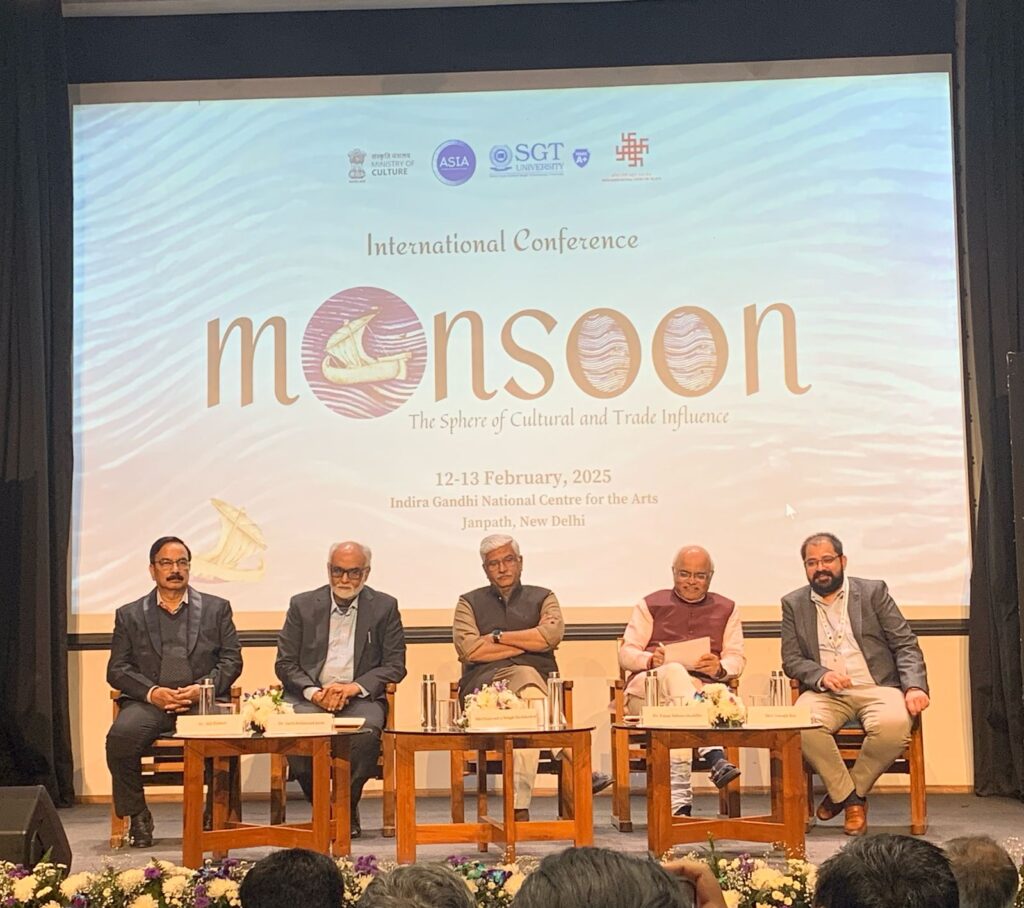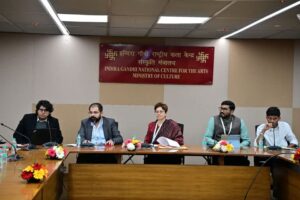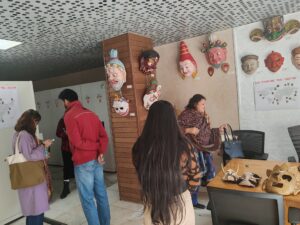Launch of the ‘Monsoon’ Digital Platform by Hon’ble Minister of Culture and Tourism, Shri Gajendra Singh Shekhawat

New Delhi: 14 February 2025: The international conference, Monsoon: The Sphere of Cultural and Trade Influence, was successfully convened at the Indira Gandhi National Centre for the Arts (IGNCA), New Delhi. Scholars, policymakers, and cultural experts gathered at the conference, which was organized by the Ministry of Culture, IGNCA, and the Advanced Study Institute of Asia (ASIA Research), SGT University, to examine the profound historical, cultural, and economic ties that have been shaped by the monsoon throughout South and Southeast Asia.
Shri Gajendra Singh Shekhawat, the Hon’ble Minister of Culture and Tourism, inaugurated the conference and introduced the groundbreaking Monsoon digital platform with his distinguished presence. This digital library curates stories of intellectual and cultural interaction, maps historical trade routes, and documents heritage sites.
 The inaugural session featured notable addresses by IGNCA Member Secretary, Dr. Sachchidanand Joshi, who highlighted the significance of linguistic and intellectual connections with neighboring countries, as well as India’s global cultural impact.
The inaugural session featured notable addresses by IGNCA Member Secretary, Dr. Sachchidanand Joshi, who highlighted the significance of linguistic and intellectual connections with neighboring countries, as well as India’s global cultural impact.
Senior BJP politician and former MP, Shri Vinay Sahasrabuddhe, emphasized the strength of India’s cultural linkages with Southeast Asia and called for a renewed focus on India’s historical connections.
Prof. Amogh Rai, Research Director of ASIA Research, provided an overview of the conference’s academic and cultural significance, emphasizing how historical exchanges have shaped identities, governance, and traditions in the monsoon region.
Speaking at the event, the Hon’ble Minister of Culture and Tourism, Shri Gajendra Singh Shekhawat. remarked, “Monsoon has always been integral to our civilization. The cultural impact across the Indian Ocean is undeniable, and our diverse heritage is a matter of pride. Project Mausam is a vital initiative in strengthening our maritime and cultural legacy.” “He further emphasized the significance of India’s historical economic and trade ties with other nations, highlighting the monsoon’s integral role in India’s civilization and the importance of cultural diplomacy in reinforcing these connections.
Shri Vinay Sahasrabuddhe, a senior BJP member and former MP, called for a renewed emphasis on India’s historical ties with Southeast Asia and underscored the depth of India’s cultural connections with the region. He remarked, “Monsoon, in the context of this part of the globe, symbolises India’s eternal linkage with the entire South East Asia. India has to lead the entire community of smaller nations in South East Asia, Africa and Latin America as well. We must recognise the centrality of culture while working on the idea of greater South-South Cooperation mooted by Prime Minister Narendra Modi. In fact, in this year of Amrut Mahotsav of our Constitution, it is all the more appropriate to revisit the idea of Cultural Commonwealth with South East Asian and other countries, propounded by Dr Babasaheb Ambedkar and endorsed by Pt Deendayal Upadhyay.”
Following the inaugural session, the conference hosted thought-provoking panel discussions insightful topics such as Buddhist soft power and maritime trade networks, oft power diplomacy and cultural identity, Indian Ocean trade and its influence on the Arab world, the role of Sri Lankan settlers in shaping cultural landscapes and the modernization of cultural identities across South and Southeast Asia.
 A gallery walk and exhibition complemented the academic sessions, offering attendees a unique visual exploration of historical maritime networks. Rare historical maps, nautical charts, and satellite data that portray changing views of the Indian Ocean world are on display in the exhibition Indian Ocean Through the Lens of Maps: A Visual History of Exchange and Empire. It showcases the work of Arab navigators, Greco-Roman geographers, and colonial explorers, demonstrating the centuries-long impact of mapping on trade, geopolitics, and cross-cultural interactions.
A gallery walk and exhibition complemented the academic sessions, offering attendees a unique visual exploration of historical maritime networks. Rare historical maps, nautical charts, and satellite data that portray changing views of the Indian Ocean world are on display in the exhibition Indian Ocean Through the Lens of Maps: A Visual History of Exchange and Empire. It showcases the work of Arab navigators, Greco-Roman geographers, and colonial explorers, demonstrating the centuries-long impact of mapping on trade, geopolitics, and cross-cultural interactions.
A series of books that provide comprehensive information on historical commerce, religious interactions, heritage sites, and kingdom profiles in the Indian Ocean region have been compiled as part of the program. These books, accompanied by maps, images, and archival documents, are a priceless resource for scholars, teachers, and history buffs.
The second day of the conference featured deep-dive discussions on South and Southeast Asian history, culture, and heritage. Notable sessions included a discussion by Lt. Commander Neeraj Vashisth, author of Ayodhya to Ayutthaya: Relationship Transcending Faith and Time, exploring India-Southeast Asia cultural ties, panel discussions on cultural diplomacy, Puranic traditions in the Funan Kingdom, and hybridization of cultures, an engaging discourse on the role of South Indian music in shaping the cultural landscapes of Southeast Asia, a session on Tamil traders’ influence on Javanese temples, particularly Prambanan. A presentation on traditional performing arts like Arbana Muttu and Duff Muttu from the Malabar region and their Arab world connections, and explorations of the significance of Wat Bo Pagoda and the presence of Ramayana across South and Southeast Asia were also included.
The conference concluded with a keynote address by Shri Suresh Soni, an eminent RSS leader, who emphasized India’s longstanding cultural dialogues, the historical depth of its knowledge traditions, and the importance of presenting an accurate representation of India’s history spanning over 2,500 years. He highlighted the ancient value systems embedded in Indian trade and cultural exchanges, emphasizing the integral philosophy within temple structures and the interconnectedness of knowledge systems.
The event concluded with an awards ceremony recognizing the best presentation and best paper, leaving participants enriched by the vibrant exchange of ideas and scholarly insights.
Monsoon: The Sphere of Cultural and Trade Influence is a key initiative under Project Mausam, focusing on India’s historical maritime and cultural connections with South and Southeast Asia. Through academic discourse and digital innovation, the conference and its associated Monsoon platform aim to bridge historical narratives with modern research, fostering a deeper understanding of shared heritage and cross-cultural interactions.
The Indira Gandhi National Centre for the Arts (IGNCA) is a premier government-funded institution dedicated to the preservation and promotion of India’s cultural heritage. Established in 1987, IGNCA serves as a research, documentation, and resource center for the arts, covering visual, literary, and performing traditions. It engages in interdisciplinary studies, digital archiving, and exhibitions to foster a deeper understanding of India’s artistic and intellectual traditions.
The Ministry of Culture is responsible for the preservation and promotion of India’s tangible and intangible cultural heritage. It implements various schemes and programs related to literature, visual and performing arts, and cultural research. The Ministry also oversees institutions and initiatives that foster cultural exchange, documentation, and conservation, ensuring the continued enrichment of India’s diverse traditions.
The Advanced Study Institute of Asia (ASIA), established in 2023 and affiliated with Shree Guru Gobind Singh Tricentenary University in Gurugram, India, is an interdisciplinary research center dedicated to enhancing the understanding of Asia, particularly South and Southeast Asia. Situated in New Delhi, ASIA explores fields such as International Relations, health, law, and societal issues through a multidisciplinary lens, leveraging the expertise of scholars and practitioners. Over the past year, it has initiated diverse projects spanning historical, political, and health-related themes, disseminating research through publications, ASIA SenseMaker conversations, videos, podcasts, and newsletters. With a dedicated team of young researchers actively engaging in public discourse and academic discussions, ASIA fosters collaboration and networking across various thematic areas. Looking ahead, it aims to expand its research scope to include primary studies alongside secondary analyses, further strengthening its contributions as a critical think tank in the region.